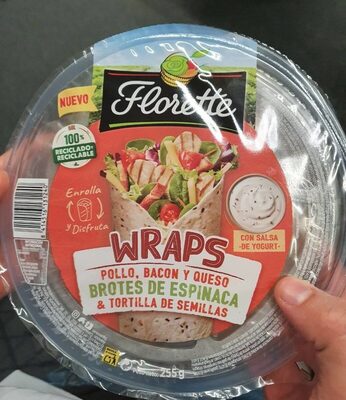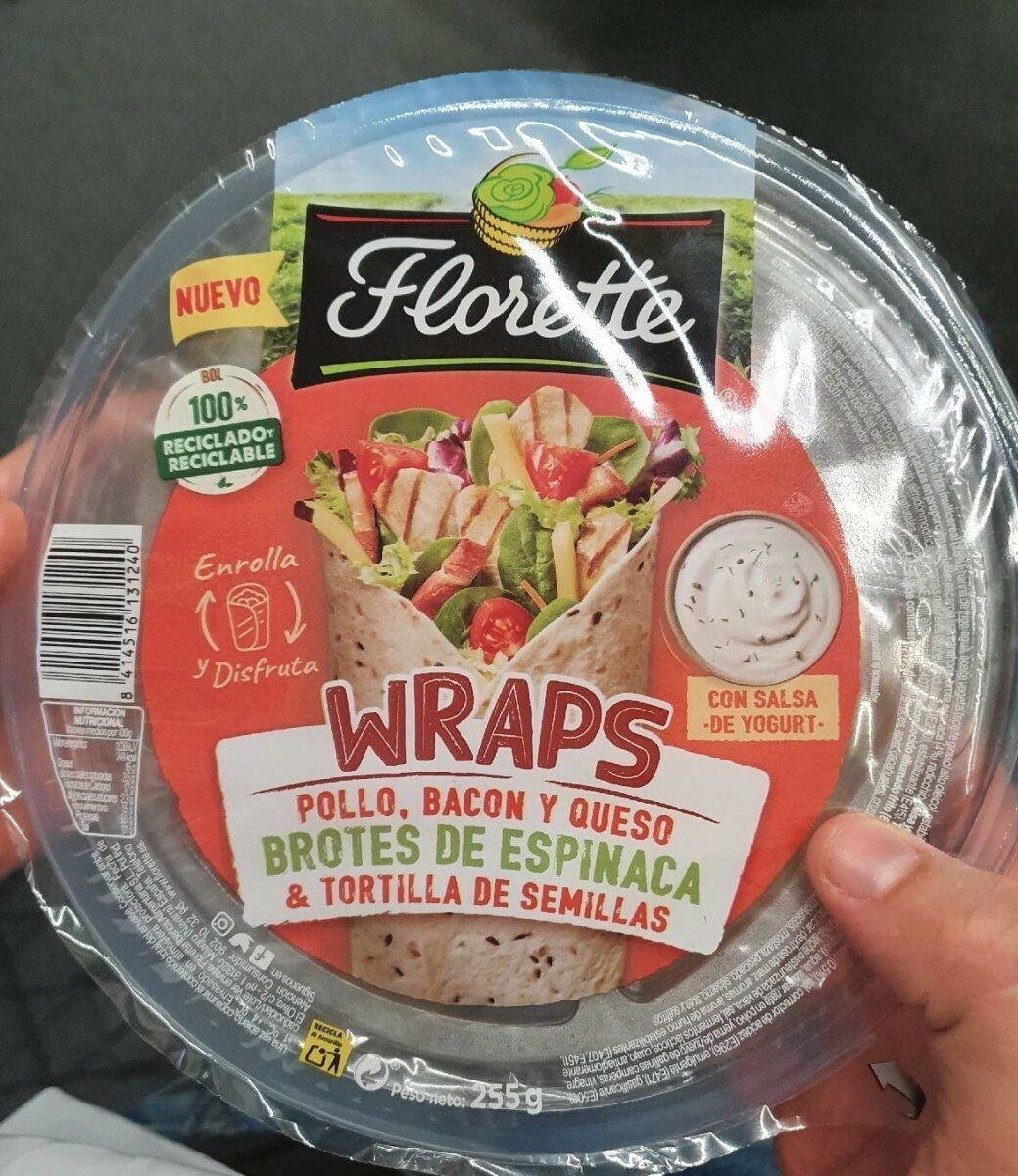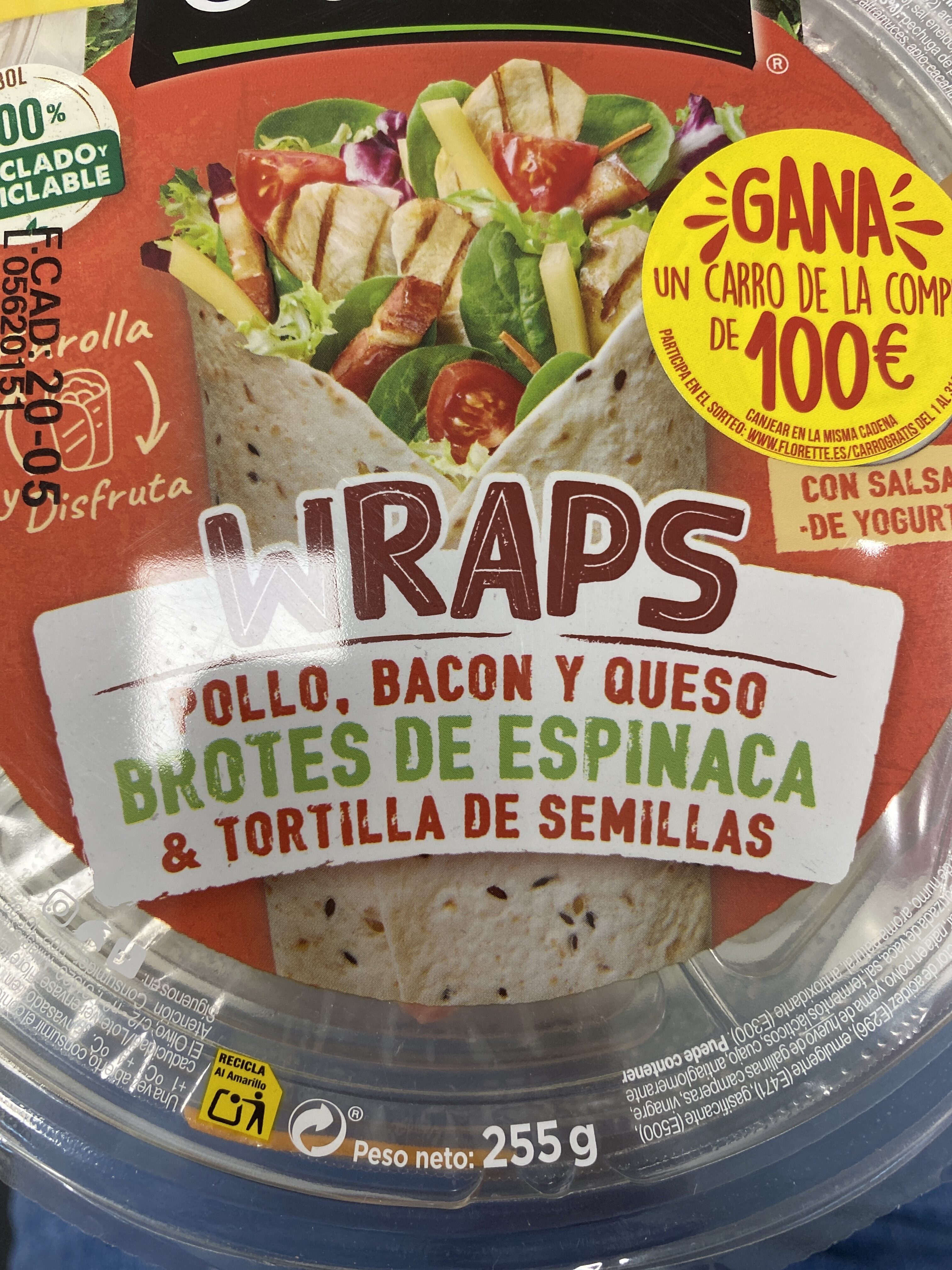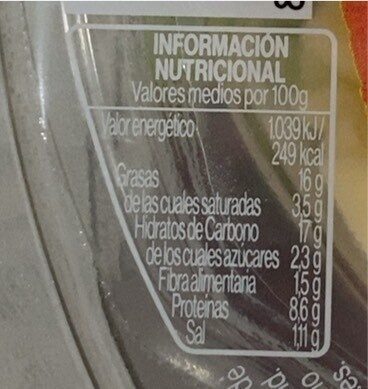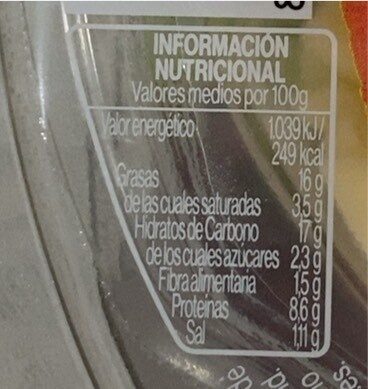Help us make food transparency the norm!
As a non-profit organization, we depend on your donations to continue informing consumers around the world about what they eat.
The food revolution starts with you!
Florette wraps - 255 g
Florette wraps - 255 g
This product page is not complete. You can help to complete it by editing it and adding more data from the photos we have, or by taking more photos using the app for Android or iPhone/iPad. Thank you!
×
Barra-kodea: 8414516131240 (EAN / EAN-13)
Kopurua: 255 g
Markak: Florette
Kategoriak: en:Meals, en:Prepared salads
Etiketak, ziurtagiriak, sariak:
en:Green Dot
Origin of the product and/or its ingredients: España
Link to the product page on the official site of the producer: https://www.florette.es/productos/wraps/...
Dendak: AhorraMas
Saltzen diren herrialdeak: Espainia
Matching with your preferences
Health
Osagaiak
-
78 ingredients
: Tortillas de harina de trigo multicereal (28%): harina de trigo, agua, aceite vegetal (aceite girasol alto oleico), estabilizantes (E422, E412), semillas de lino (0,5%), sal, corrector de acidez (E296), emulgente (E471), gasificante (E500), conservadores (E281, E202), aroma natural. Mezcla de hortalizas en proporción variable: escarola lisa, zanahoria, brote espinaca (4%), radicchio. Salsa yogurt (19,6%): aceite vegetal (girasol), agua, azúcar, nata en polvo, yema de huevo de gallinas camperas, vinagre, yogurt en polvo (0,3%), sal, eneldo, jugo de limón concentrado, almidón modificado, aromas naturales (leche), acidulantes (E270), estabilizante (E415). Tomate. Queso gouda light (9%): leche pasteurizada de vaca, sal, fermentos lácticos, cuajo, antiaglomerante (E460). Pollo (8%): pechuga de pollo, sal, dextrosa, aromas naturales, estabilizante (E451i), espesante (E407). Bacon cocido ahumado frito (6%): panceta de cerdo, sal, azúcar, dextrosa de maíz, aromas, aroma de humo, estabilizantes (E407, E451), antioxidantes (E316, E331), conservador (E250), aceite de fritura (girasol).Alergenoak: en:Gluten, en:Milk
Food processing
-
Ultra processed foods
Elements that indicate the product is in the 4 - Ultra prozesatutako elikagaiak eta edariak group:
- Gehigarria: E14XX
- Gehigarria: E407
- Gehigarria: E412
- Gehigarria: E415
- Gehigarria: E422 - Glizerina
- Gehigarria: E451
- Gehigarria: E460 - Zelulosa
- Gehigarria: E471
- Osagaia: Dextrose
- Osagaia: Emulsifier
- Osagaia: Flavouring
- Osagaia: Glukosa
- Osagaia: Thickener
Food products are classified into 4 groups according to their degree of processing:
- Prozesatu gabeko edo ahalik eta gutxien prozesatutako elikagaiak
- Sukaldaritzako osagaiak prozesatu
- Prozesatutako jakiak
- Ultra processed foods
The determination of the group is based on the category of the product and on the ingredients it contains.
Gehigarriak
-
E202
Potassium sorbate: Potassium sorbate is the potassium salt of sorbic acid, chemical formula CH3CH=CH−CH=CH−CO2K. It is a white salt that is very soluble in water -58.2% at 20 °C-. It is primarily used as a food preservative -E number 202-. Potassium sorbate is effective in a variety of applications including food, wine, and personal-care products. While sorbic acid is naturally occurring in some berries, virtually all of the world's production of sorbic acid, from which potassium sorbate is derived, is manufactured synthetically.Source: Wikipedia (Ingeles)
-
E250
Sodium nitrite: Sodium nitrite is the inorganic compound with the chemical formula NaNO2. It is a white to slightly yellowish crystalline powder that is very soluble in water and is hygroscopic. It is a useful precursor to a variety of organic compounds, such as pharmaceuticals, dyes, and pesticides, but it is probably best known as a food additive to prevent botulism. It is on the World Health Organization's List of Essential Medicines, the most important medications needed in a basic health system.Nitrate or nitrite -ingested- under conditions that result in endogenous nitrosation has been classified as "probably carcinogenic to humans" by International Agency for Research on Cancer -IARC-.Source: Wikipedia (Ingeles)
-
E270
Lactic acid: Lactic acid is an organic compound with the formula CH3CH-OH-COOH. In its solid state, it is white and water-soluble. In its liquid state, it is colorless. It is produced both naturally and synthetically. With a hydroxyl group adjacent to the carboxyl group, lactic acid is classified as an alpha-hydroxy acid -AHA-. In the form of its conjugate base called lactate, it plays a role in several biochemical processes. In solution, it can ionize a proton from the carboxyl group, producing the lactate ion CH3CH-OH-CO−2. Compared to acetic acid, its pKa is 1 unit less, meaning lactic acid deprotonates ten times more easily than acetic acid does. This higher acidity is the consequence of the intramolecular hydrogen bonding between the α-hydroxyl and the carboxylate group. Lactic acid is chiral, consisting of two optical isomers. One is known as L--+--lactic acid or -S--lactic acid and the other, its mirror image, is D--−--lactic acid or -R--lactic acid. A mixture of the two in equal amounts is called DL-lactic acid, or racemic lactic acid. Lactic acid is hygroscopic. DL-lactic acid is miscible with water and with ethanol above its melting point which is around 17 or 18 °C. D-lactic acid and L-lactic acid have a higher melting point. In animals, L-lactate is constantly produced from pyruvate via the enzyme lactate dehydrogenase -LDH- in a process of fermentation during normal metabolism and exercise. It does not increase in concentration until the rate of lactate production exceeds the rate of lactate removal, which is governed by a number of factors, including monocarboxylate transporters, concentration and isoform of LDH, and oxidative capacity of tissues. The concentration of blood lactate is usually 1–2 mM at rest, but can rise to over 20 mM during intense exertion and as high as 25 mM afterward. In addition to other biological roles, L-lactic acid is the primary endogenous agonist of hydroxycarboxylic acid receptor 1 -HCA1-, which is a Gi/o-coupled G protein-coupled receptor -GPCR-.In industry, lactic acid fermentation is performed by lactic acid bacteria, which convert simple carbohydrates such as glucose, sucrose, or galactose to lactic acid. These bacteria can also grow in the mouth; the acid they produce is responsible for the tooth decay known as caries. In medicine, lactate is one of the main components of lactated Ringer's solution and Hartmann's solution. These intravenous fluids consist of sodium and potassium cations along with lactate and chloride anions in solution with distilled water, generally in concentrations isotonic with human blood. It is most commonly used for fluid resuscitation after blood loss due to trauma, surgery, or burns.Source: Wikipedia (Ingeles)
-
E281
Sodium propionate: Sodium propanoate or sodium propionate is the sodium salt of propionic acid which has the chemical formula Na-C2H5COO-. This white crystalline solid is deliquescent in moist air.Source: Wikipedia (Ingeles)
-
E296 - Azido maliko
Malic acid: Malic acid is an organic compound with the molecular formula C4H6O5. It is a dicarboxylic acid that is made by all living organisms, contributes to the pleasantly sour taste of fruits, and is used as a food additive. Malic acid has two stereoisomeric forms -L- and D-enantiomers-, though only the L-isomer exists naturally. The salts and esters of malic acid are known as malates. The malate anion is an intermediate in the citric acid cycle.Source: Wikipedia (Ingeles)
-
E316
Sodium erythorbate: Sodium erythorbate -C6H7NaO6- is a food additive used predominantly in meats, poultry, and soft drinks. Chemically, it is the sodium salt of erythorbic acid. When used in processed meat such as hot dogs and beef sticks, it increases the rate at which nitrite reduces to nitric oxide, thus facilitating a faster cure and retaining the pink coloring. As an antioxidant structurally related to vitamin C, it helps improve flavor stability and prevents the formation of carcinogenic nitrosamines. When used as a food additive, its E number is E316. The use of erythorbic acid and sodium erythorbate as a food preservative has increased greatly since the U.S. Food and Drug Administration banned the use of sulfites as preservatives in foods intended to be eaten fresh -such as ingredients for fresh salads- and as food processors have responded to the fact that some people are allergic to sulfites. It can also be found in bologna, and is occasionally used in beverages, baked goods, and potato salad.Sodium erythorbate is produced from sugars derived from different sources, such as beets, sugar cane, and corn. An urban myth claims that sodium erythorbate is made from ground earthworms; however, there is no truth to the myth. It is thought that the genesis of the legend comes from the similarity of the chemical name to the words earthworm and bait.Alternative applications include the development of additives that could be utilized as anti-oxidants in general. For instance, this substance has been implemented in the development of corrosion inhibitors for metals and it has been implemented in active packaging.Sodium erythorbate is soluble in water. The pH of the aqueous solution of the sodium salt is between 5 and 6. A 10% solution, made from commercial grade sodium erythorbate, may have a pH of 7.2 to 7.9. In its dry, crystalline state it is nonreactive. But, when in solution with water it readily reacts with atmospheric oxygen and other oxidizing agents, which makes it a valuable antioxidant.Source: Wikipedia (Ingeles)
-
E331
Sodium citrate: Sodium citrate may refer to any of the sodium salts of citrate -though most commonly the third-: Monosodium citrate Disodium citrate Trisodium citrateThe three forms of the salt are collectively known by the E number E331. Sodium citrates are used as acidity regulators in food and drinks, and also as emulsifiers for oils. They enable cheeses to melt without becoming greasy.Source: Wikipedia (Ingeles)
-
E407
Carrageenan: Carrageenans or carrageenins - karr-ə-gee-nənz, from Irish carraigín, "little rock"- are a family of linear sulfated polysaccharides that are extracted from red edible seaweeds. They are widely used in the food industry, for their gelling, thickening, and stabilizing properties. Their main application is in dairy and meat products, due to their strong binding to food proteins. There are three main varieties of carrageenan, which differ in their degree of sulfation. Kappa-carrageenan has one sulfate group per disaccharide, iota-carrageenan has two, and lambda-carrageenan has three. Gelatinous extracts of the Chondrus crispus -Irish moss- seaweed have been used as food additives since approximately the fifteenth century. Carrageenan is a vegetarian and vegan alternative to gelatin in some applications or may be used to replace gelatin in confectionery.Source: Wikipedia (Ingeles)
-
E412
Guar gum: Guar gum, also called guaran, is a galactomannan polysaccharide extracted from guar beans that has thickening and stabilizing properties useful in the food, feed and industrial applications. The guar seeds are mechanically dehusked, hydrated, milled and screened according to application. It is typically produced as a free-flowing, off-white powder.Source: Wikipedia (Ingeles)
-
E415
Xanthan gum: Xanthan gum -- is a polysaccharide with many industrial uses, including as a common food additive. It is an effective thickening agent and stabilizer to prevent ingredients from separating. It can be produced from simple sugars using a fermentation process, and derives its name from the species of bacteria used, Xanthomonas campestris.Source: Wikipedia (Ingeles)
-
E422 - Glizerina
Glycerol: Glycerol -; also called glycerine or glycerin; see spelling differences- is a simple polyol compound. It is a colorless, odorless, viscous liquid that is sweet-tasting and non-toxic. The glycerol backbone is found in all lipids known as triglycerides. It is widely used in the food industry as a sweetener and humectant and in pharmaceutical formulations. Glycerol has three hydroxyl groups that are responsible for its solubility in water and its hygroscopic nature.Source: Wikipedia (Ingeles)
-
E451
Sodium triphosphate: Sodium triphosphate -STP-, also sodium tripolyphosphate -STPP-, or tripolyphosphate -TPP-,- is an inorganic compound with formula Na5P3O10. It is the sodium salt of the polyphosphate penta-anion, which is the conjugate base of triphosphoric acid. It is produced on a large scale as a component of many domestic and industrial products, especially detergents. Environmental problems associated with eutrophication are attributed to its widespread use.Source: Wikipedia (Ingeles)
-
E451i
Sodium triphosphate: Sodium triphosphate -STP-, also sodium tripolyphosphate -STPP-, or tripolyphosphate -TPP-,- is an inorganic compound with formula Na5P3O10. It is the sodium salt of the polyphosphate penta-anion, which is the conjugate base of triphosphoric acid. It is produced on a large scale as a component of many domestic and industrial products, especially detergents. Environmental problems associated with eutrophication are attributed to its widespread use.Source: Wikipedia (Ingeles)
-
E460 - Zelulosa
Cellulose: Cellulose is an organic compound with the formula -C6H10O5-n, a polysaccharide consisting of a linear chain of several hundred to many thousands of β-1→4- linked D-glucose units. Cellulose is an important structural component of the primary cell wall of green plants, many forms of algae and the oomycetes. Some species of bacteria secrete it to form biofilms. Cellulose is the most abundant organic polymer on Earth. The cellulose content of cotton fiber is 90%, that of wood is 40–50%, and that of dried hemp is approximately 57%.Cellulose is mainly used to produce paperboard and paper. Smaller quantities are converted into a wide variety of derivative products such as cellophane and rayon. Conversion of cellulose from energy crops into biofuels such as cellulosic ethanol is under development as a renewable fuel source. Cellulose for industrial use is mainly obtained from wood pulp and cotton.Some animals, particularly ruminants and termites, can digest cellulose with the help of symbiotic micro-organisms that live in their guts, such as Trichonympha. In human nutrition, cellulose is a non-digestible constituent of insoluble dietary fiber, acting as a hydrophilic bulking agent for feces and potentially aiding in defecation.Source: Wikipedia (Ingeles)
-
E471
Mono- and diglycerides of fatty acids: Mono- and diglycerides of fatty acids -E471- refers to a food additive composed of diglycerides and monoglycerides which is used as an emulsifier. This mixture is also sometimes referred to as partial glycerides.Source: Wikipedia (Ingeles)
-
E500
Sodium carbonate: Sodium carbonate, Na2CO3, -also known as washing soda, soda ash and soda crystals, and in the monohydrate form as crystal carbonate- is the water-soluble sodium salt of carbonic acid. It most commonly occurs as a crystalline decahydrate, which readily effloresces to form a white powder, the monohydrate. Pure sodium carbonate is a white, odorless powder that is hygroscopic -absorbs moisture from the air-. It has a strongly alkaline taste, and forms a moderately basic solution in water. Sodium carbonate is well known domestically for its everyday use as a water softener. Historically it was extracted from the ashes of plants growing in sodium-rich soils, such as vegetation from the Middle East, kelp from Scotland and seaweed from Spain. Because the ashes of these sodium-rich plants were noticeably different from ashes of timber -used to create potash-, they became known as "soda ash". It is synthetically produced in large quantities from salt -sodium chloride- and limestone by a method known as the Solvay process. The manufacture of glass is one of the most important uses of sodium carbonate. Sodium carbonate acts as a flux for silica, lowering the melting point of the mixture to something achievable without special materials. This "soda glass" is mildly water-soluble, so some calcium carbonate is added to the melt mixture to make the glass produced insoluble. This type of glass is known as soda lime glass: "soda" for the sodium carbonate and "lime" for the calcium carbonate. Soda lime glass has been the most common form of glass for centuries. Sodium carbonate is also used as a relatively strong base in various settings. For example, it is used as a pH regulator to maintain stable alkaline conditions necessary for the action of the majority of photographic film developing agents. It acts as an alkali because when dissolved in water, it dissociates into the weak acid: carbonic acid and the strong alkali: sodium hydroxide. This gives sodium carbonate in solution the ability to attack metals such as aluminium with the release of hydrogen gas.It is a common additive in swimming pools used to raise the pH which can be lowered by chlorine tablets and other additives which contain acids. In cooking, it is sometimes used in place of sodium hydroxide for lyeing, especially with German pretzels and lye rolls. These dishes are treated with a solution of an alkaline substance to change the pH of the surface of the food and improve browning. In taxidermy, sodium carbonate added to boiling water will remove flesh from the bones of animal carcasses for trophy mounting or educational display. In chemistry, it is often used as an electrolyte. Electrolytes are usually salt-based, and sodium carbonate acts as a very good conductor in the process of electrolysis. In addition, unlike chloride ions, which form chlorine gas, carbonate ions are not corrosive to the anodes. It is also used as a primary standard for acid-base titrations because it is solid and air-stable, making it easy to weigh accurately.Source: Wikipedia (Ingeles)
Ingredients analysis
-
en:May contain palm oil
Ingredients that may contain palm oil: E471
-
en:Non-vegan
Non-vegan ingredients: Esne-gaina, en:Free range chicken egg yolk, Esne, en:Pasteurised cow's milk, Oilo, en:Chicken breast, Hirugihar, en:Pork breastSome ingredients could not be recognized.
We need your help!
You can help us recognize more ingredients and better analyze the list of ingredients for this product and others:
- Edit this product page to correct spelling mistakes in the ingredients list, and/or to remove ingredients in other languages and sentences that are not related to the ingredients.
- Add new entries, synonyms or translations to our multilingual lists of ingredients, ingredient processing methods, and labels.
If you would like to help, join the #ingredients channel on our Slack discussion space and/or learn about ingredients analysis on our wiki. Thank you!
-
en:Non-vegetarian
Non-vegetarian ingredients: Oilo, en:Chicken breast, Hirugihar, en:Pork breastSome ingredients could not be recognized.
We need your help!
You can help us recognize more ingredients and better analyze the list of ingredients for this product and others:
- Edit this product page to correct spelling mistakes in the ingredients list, and/or to remove ingredients in other languages and sentences that are not related to the ingredients.
- Add new entries, synonyms or translations to our multilingual lists of ingredients, ingredient processing methods, and labels.
If you would like to help, join the #ingredients channel on our Slack discussion space and/or learn about ingredients analysis on our wiki. Thank you!
-
Details of the analysis of the ingredients
We need your help!
Some ingredients could not be recognized.
We need your help!
You can help us recognize more ingredients and better analyze the list of ingredients for this product and others:
- Edit this product page to correct spelling mistakes in the ingredients list, and/or to remove ingredients in other languages and sentences that are not related to the ingredients.
- Add new entries, synonyms or translations to our multilingual lists of ingredients, ingredient processing methods, and labels.
If you would like to help, join the #ingredients channel on our Slack discussion space and/or learn about ingredients analysis on our wiki. Thank you!
: Tortillas de harina de trigo multicereal 28% (harina de trigo), agua, aceite vegetal (aceite girasol alto oleico), estabilizantes (e422, e412), semillas de lino 0.5%, sal, corrector de acidez (e296), emulgente (e471), gasificante (e500), conservadores (e281, e202), aroma natural, hortalizas en proporción variable (escarola lisa), zanahoria, brote espinaca 4%, radicchio, Salsa yogurt 19.6% (aceite vegetal (girasol)), agua, azúcar, nata, yema de huevo de gallinas camperas, vinagre, yogurt en polvo 0.3%, sal, eneldo, jugo de limón concentrado, almidón modificado, aromas naturales (leche), acidulantes (e270), estabilizante (e415), Tomate, Queso gouda light 9% (leche pasteurizada de vaca), sal, fermentos lácticos, cuajo, antiaglomerante (e460), Pollo 8% (pechuga de pollo), sal, dextrosa, aromas naturales, estabilizante (e451i), espesante (e407), Bacon 6% (panceta de cerdo), sal, azúcar, dextrosa de maíz, aromas, aroma de humo, estabilizantes (e407, e451), antioxidantes (e316, e331), conservador (e250), aceite de fritura (girasol)- Tortillas de harina de trigo multicereal -> es:tortillas-de-harina-de-trigo-multicereal - percent: 28
- harina de trigo -> en:wheat-flour - vegan: yes - vegetarian: yes - ciqual_proxy_food_code: 9410
- agua -> en:water - vegan: yes - vegetarian: yes - ciqual_food_code: 18066
- aceite vegetal -> en:vegetable-oil - vegan: yes - vegetarian: yes - from_palm_oil: maybe
- aceite girasol alto oleico -> en:high-oleic-sunflower-oil - vegan: yes - vegetarian: yes - from_palm_oil: no - ciqual_food_code: 17440
- estabilizantes -> en:stabiliser
- e422 -> en:e422 - vegan: maybe - vegetarian: maybe
- e412 -> en:e412 - vegan: yes - vegetarian: yes
- semillas de lino -> en:flax-seed - vegan: yes - vegetarian: yes - ciqual_food_code: 15034 - percent: 0.5
- sal -> en:salt - vegan: yes - vegetarian: yes - ciqual_food_code: 11058
- corrector de acidez -> en:acidity-regulator
- e296 -> en:e296 - vegan: yes - vegetarian: yes
- emulgente -> en:emulsifier
- e471 -> en:e471 - vegan: maybe - vegetarian: maybe - from_palm_oil: maybe
- gasificante -> en:raising-agent
- e500 -> en:e500 - vegan: yes - vegetarian: yes
- conservadores -> en:preservative
- e281 -> en:e281 - vegan: yes - vegetarian: yes
- e202 -> en:e202 - vegan: yes - vegetarian: yes
- aroma natural -> en:natural-flavouring - vegan: maybe - vegetarian: maybe
- hortalizas en proporción variable -> en:vegetables-in-variable-proportion - vegan: yes - vegetarian: yes
- escarola lisa -> en:broad-leaved-endive - vegan: yes - vegetarian: yes
- zanahoria -> en:carrot - vegan: yes - vegetarian: yes - ciqual_food_code: 20009
- brote espinaca -> es:brote-espinaca - percent: 4
- radicchio -> en:radicchio - vegan: yes - vegetarian: yes
- Salsa yogurt -> es:salsa-yogurt - percent: 19.6
- aceite vegetal -> en:vegetable-oil - vegan: yes - vegetarian: yes - from_palm_oil: maybe
- girasol -> en:sunflower - vegan: yes - vegetarian: yes
- aceite vegetal -> en:vegetable-oil - vegan: yes - vegetarian: yes - from_palm_oil: maybe
- agua -> en:water - vegan: yes - vegetarian: yes - ciqual_food_code: 18066
- azúcar -> en:sugar - vegan: yes - vegetarian: yes - ciqual_proxy_food_code: 31016
- nata -> en:cream - vegan: no - vegetarian: yes - ciqual_food_code: 19402
- yema de huevo de gallinas camperas -> en:free-range-chicken-egg-yolk - vegan: no - vegetarian: yes - ciqual_food_code: 22002
- vinagre -> en:vinegar - vegan: yes - vegetarian: yes - ciqual_food_code: 11018
- yogurt en polvo -> es:yogurt-en-polvo - percent: 0.3
- sal -> en:salt - vegan: yes - vegetarian: yes - ciqual_food_code: 11058
- eneldo -> en:dill - vegan: yes - vegetarian: yes - ciqual_food_code: 11093
- jugo de limón concentrado -> en:concentrated-lemon-juice - vegan: yes - vegetarian: yes - ciqual_food_code: 2028
- almidón modificado -> en:modified-starch - vegan: yes - vegetarian: yes - ciqual_proxy_food_code: 9510
- aromas naturales -> en:natural-flavouring - vegan: maybe - vegetarian: maybe
- leche -> en:milk - vegan: no - vegetarian: yes - ciqual_proxy_food_code: 19051
- acidulantes -> en:acid
- e270 -> en:e270 - vegan: yes - vegetarian: yes
- estabilizante -> en:stabiliser
- e415 -> en:e415 - vegan: yes - vegetarian: yes
- Tomate -> en:tomato - vegan: yes - vegetarian: yes - ciqual_food_code: 20047
- Queso gouda light -> es:queso-gouda-light - percent: 9
- leche pasteurizada de vaca -> en:pasteurised-cow-s-milk - vegan: no - vegetarian: yes - ciqual_proxy_food_code: 19051
- sal -> en:salt - vegan: yes - vegetarian: yes - ciqual_food_code: 11058
- fermentos lácticos -> en:lactic-ferments - vegan: maybe - vegetarian: yes
- cuajo -> en:rennet - vegan: maybe - vegetarian: maybe
- antiaglomerante -> en:anti-caking-agent
- e460 -> en:e460 - vegan: yes - vegetarian: yes
- Pollo -> en:chicken - vegan: no - vegetarian: no - percent: 8
- pechuga de pollo -> en:chicken-breast - vegan: no - vegetarian: no - ciqual_food_code: 36018
- sal -> en:salt - vegan: yes - vegetarian: yes - ciqual_food_code: 11058
- dextrosa -> en:dextrose - vegan: yes - vegetarian: yes - ciqual_proxy_food_code: 31016
- aromas naturales -> en:natural-flavouring - vegan: maybe - vegetarian: maybe
- estabilizante -> en:stabiliser
- e451i -> en:e451i - vegan: yes - vegetarian: yes
- espesante -> en:thickener
- e407 -> en:e407 - vegan: yes - vegetarian: yes
- Bacon -> en:bacon - vegan: no - vegetarian: no - ciqual_food_code: 28858 - percent: 6
- panceta de cerdo -> en:pork-breast - vegan: no - vegetarian: no - ciqual_proxy_food_code: 28205
- sal -> en:salt - vegan: yes - vegetarian: yes - ciqual_food_code: 11058
- azúcar -> en:sugar - vegan: yes - vegetarian: yes - ciqual_proxy_food_code: 31016
- dextrosa de maíz -> en:corn-dextrose - vegan: yes - vegetarian: yes - ciqual_proxy_food_code: 31016
- aromas -> en:flavouring - vegan: maybe - vegetarian: maybe
- aroma de humo -> en:smoke-flavouring - vegan: maybe - vegetarian: maybe
- estabilizantes -> en:stabiliser
- e407 -> en:e407 - vegan: yes - vegetarian: yes
- e451 -> en:e451 - vegan: yes - vegetarian: yes
- antioxidantes -> en:antioxidant
- e316 -> en:e316 - vegan: yes - vegetarian: yes
- e331 -> en:e331 - vegan: yes - vegetarian: yes
- conservador -> en:preservative
- e250 -> en:e250 - vegan: yes - vegetarian: yes
- aceite de fritura -> es:aceite-de-fritura
- girasol -> en:sunflower - vegan: yes - vegetarian: yes
Elikadura
-
Poor nutritional quality
⚠ ️Abisua: zuntz kopurua ez dago zehaztuta, ezin izan dute kontuan izan kalifikaziorako izan dezaketen ekarpen positiboa.⚠ ️Warning: the amount of fruits, vegetables and nuts is not specified on the label, it was estimated from the list of ingredients: 0This product is not considered a beverage for the calculation of the Nutri-Score.
Positive points: 0
- Proteinak: 5 / 5 (balioa: 8.6, rounded value: 8.6)
- Fiber: 0 / 5 (balioa: 0, rounded value: 0)
- Fruits, vegetables, nuts, and colza/walnut/olive oils: 0 / 5 (balioa: 0.099609375, rounded value: 0.1)
Negative points: 16
- Energia: 3 / 10 (balioa: 1042, rounded value: 1042)
- Azukreak: 0 / 10 (balioa: 2.3, rounded value: 2.3)
- Gantz saturatua: 3 / 10 (balioa: 3.5, rounded value: 3.5)
- Sodioa: 10 / 10 (balioa: 6000, rounded value: 6000)
The points for proteins are not counted because the negative points are greater or equal to 11.
Nutritional score: (16 - 0)
Nutri-Score:
-
Nutrient levels
-
Koipe in moderate quantity (16%)
What you need to know- A high consumption of fat, especially saturated fats, can raise cholesterol, which increases the risk of heart diseases.
Recommendation: Limit the consumption of fat and saturated fat- Choose products with lower fat and saturated fat content.
-
Gantz-azido ase in moderate quantity (3.5%)
What you need to know- A high consumption of fat, especially saturated fats, can raise cholesterol, which increases the risk of heart diseases.
Recommendation: Limit the consumption of fat and saturated fat- Choose products with lower fat and saturated fat content.
-
Azukre in low quantity (2.3%)
What you need to know- A high consumption of sugar can cause weight gain and tooth decay. It also augments the risk of type 2 diabetes and cardio-vascular diseases.
Recommendation: Limit the consumption of sugar and sugary drinks- Sugary drinks (such as sodas, fruit beverages, and fruit juices and nectars) should be limited as much as possible (no more than 1 glass a day).
- Choose products with lower sugar content and reduce the consumption of products with added sugars.
-
Gatz arrunt in high quantity (15%)
What you need to know- A high consumption of salt (or sodium) can cause raised blood pressure, which can increase the risk of heart disease and stroke.
- Many people who have high blood pressure do not know it, as there are often no symptoms.
- Most people consume too much salt (on average 9 to 12 grams per day), around twice the recommended maximum level of intake.
Recommendation: Limit the consumption of salt and salted food- Reduce the quantity of salt used when cooking, and don't salt again at the table.
- Limit the consumption of salty snacks and choose products with lower salt content.
-
-
Nutrition facts
Nutrition facts As sold
for 100 g / 100 mlCompared to: en:Prepared salads Energia 1.042 kj
(249 kcal)+% 60 Koipe 16 g +% 75 Gantz-azido ase 3,5 g +% 105 Carbohydrates 17 g +% 57 Azukre 2,3 g -% 28 Fiber ? Proteina 8,6 g +% 71 Gatz arrunt 15 g +% 1.572 Fruits‚ vegetables‚ nuts and rapeseed‚ walnut and olive oils (estimate from ingredients list analysis) 0,1 %
Ingurumena
-
Eco-Score not computed - Unknown environmental impact
We could not compute the Eco-Score of this product as it is missing some data, could you help complete it?Could you add a precise product category so that we can compute the Eco-Score? Add a category
Ontziratzea
-
Packaging with a medium impact
-
Packaging parts
1 x Terrine pot (Plastic)
-
Bilgarriaren materialak
Material % Bilgarriaren pisua Bilgarriaren pisua produktuaren 100g-ko Plastic
-
Transportation
-
Origins of ingredients
Missing origins of ingredients information
⚠ ️ The origins of the ingredients of this product are not indicated.
If they are indicated on the packaging, you can modify the product sheet and add them.
If you are the manufacturer of this product, you can send us the information with our free platform for producers.Add the origins of ingredients for this product Add the origins of ingredients for this product
Report a problem
-
Incomplete or incorrect information?
Category, labels, ingredients, allergens, nutritional information, photos etc.
If the information does not match the information on the packaging, please complete or correct it. Open Food Facts is a collaborative database, and every contribution is useful for all.
Datuen iturria
Product added on by kiliweb
Last edit of product page on by foodless.
Produktuaren orria -gatik editatua charlesnepote, elcoco, ipondia, nico-bobsc2a, openfoodfacts-contributors, spotter, yuka.A-BdNtyUO8p_LdyKwdsX7j_gGsbFKuZdA2AEog, yuka.sY2b0xO6T85zoF3NwEKvlmtGWISBsjmdLSXStUy6m9PRMqb6bt5s8qXRbKo, yuka.sY2b0xO6T85zoF3NwEKvlnZdeNzSkDjOLjjSxROA3vmRd7bUbfxP_o7aHqo, yuka.sY2b0xO6T85zoF3NwEKvlndBY9eCmTHYLATUgUG5_uvefrXabNwr_673Las, yuka.sY2b0xO6T85zoF3NwEKvlndqUfrfsjHWGy7UtUaC9NK3ErHSTPd709DUEqo.
